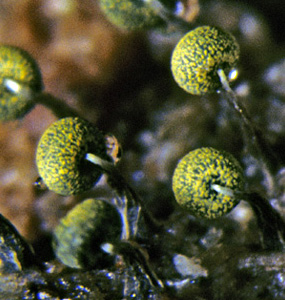Physarum viride

Image Courtesy of Henry H. Mashburn
| Click to Enlarge |
| Click For Image Gallery |
|
Group of Fungi: Slime Molds Family: Physaraceae Latin Name: Physarum viride (Bull.) Pers. Common Name: None Description: Lens-shaped structure on a slender stalk, 1/32–1/16 in (1.0–1.5 mm) tall; lens-shaped upper portion 1/64 (0.5 mm) or less in diameter, usually nodding, outer surface bright yellow at first but splitting into irregular fragments with age and revealing the black spores on the interior; stalk up to 1/32 (1.0 mm) long, tapering upward, longitudinally wrinkled, dark in color at the base and pale yellow above; spores black in mass. Biological Role: Like all other slime molds, the vegetative stage (called a plasmodium) in the life cycle of this organism feeds upon the bacteria associated with decaying plant material. Habitat: On decaying wood or bark in broadleaf or conifer forests; individual fruiting bodies crowded together in small or large groups. Geographical Distribution: Found throughout the world. Comments: The slime molds are not true fungi but are found in many of the same situations. Physarum viride sometimes occurs in large fruitings that consist of several hundred individual fruiting bodies. Fresh fruitings are often conspicuous because of their bright yellow color. Physarum album is a very similar species in which the lens-shaped upper portion of the fruiting body is white and not yellow. |
| Go Back |